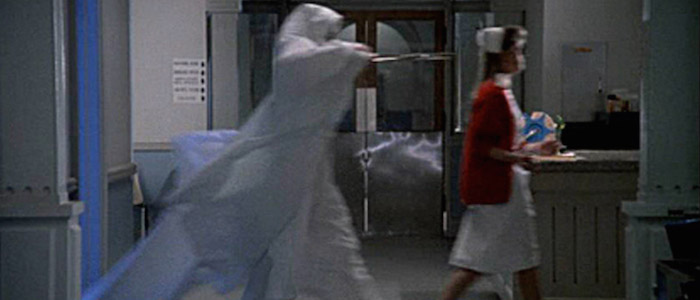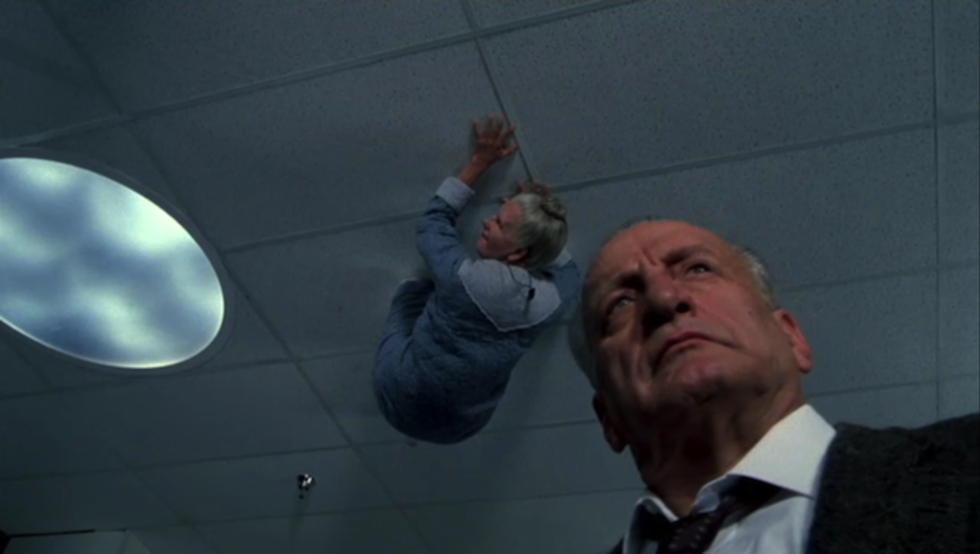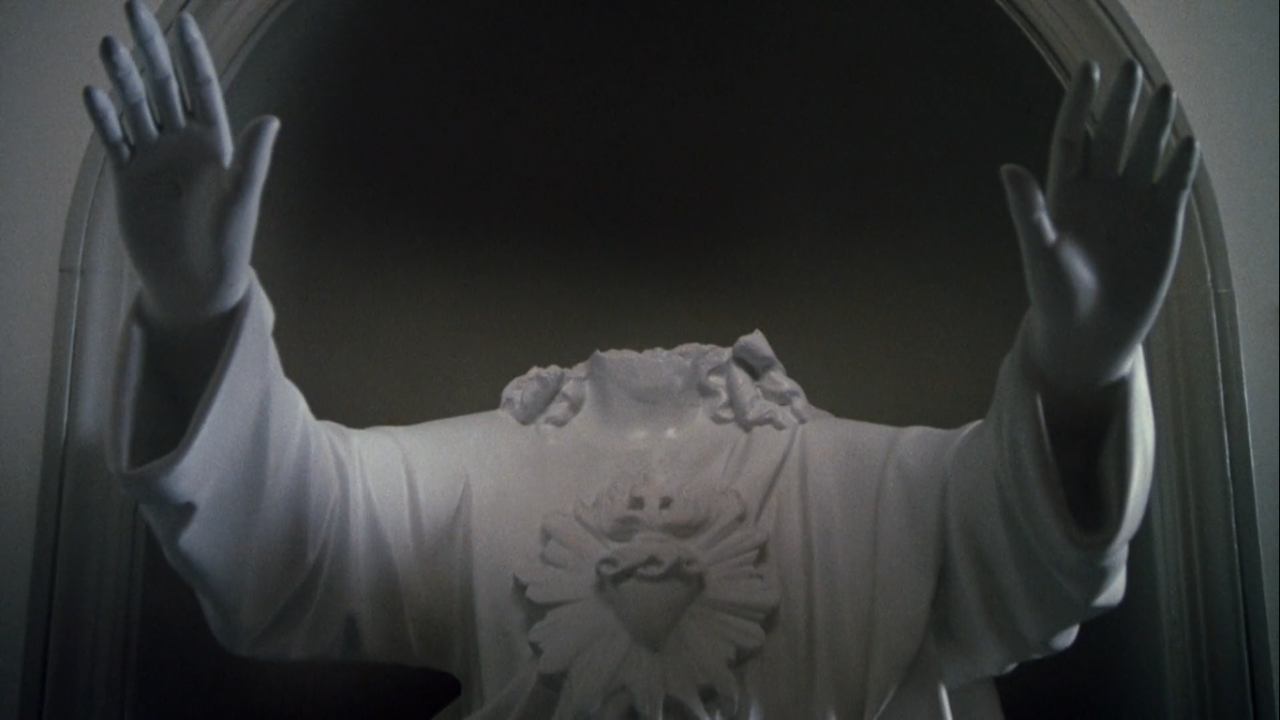MAY 19: The Exorcist III

Woe
betide the horror sequel. Shameless cash-grabs, jumped sharks, studio
interference, original cast members who have shuffled off this mortal coil and
must be replaced, beloved fictional characters who have shuffled off this mortal
coil and must be shamelessly resurrected, quick turns to comedy, non sequitur
plots masquerading as a member of the franchise, sheer absurdity – the unnecessary
horror sequel has had it all. And of all these lowly films, why have I spent
the last six months with such a fascination for The Exorcist III? Is it the famous
jump scare? The vague buzz about its reevaluation in the horror fandom
community, possibly as a result of the Shout Factory released director’s cut
that entered the world in 2016? The fact that the only thing I knew about this
movie was that it had the zodiac killer in it for some reason? Regardless, at some
point in the past six months, I announced my intention to watch The Exorcist III in the near future, my girlfriend said “why?” and it became something of
an inside joke between us. Every time we’d try to think of a movie to watch, I’d
suggest The Exorcist III and she’d say no thank you. But today, dear
reader, I finally watched it.
Yup, it’s a weird one.
The product of a troubled production
history, a combative relationship between director and producers, and seemingly
six distinct ideas that all popped into William Peter Blatty’s head at once, The Exorcist III answers the question, what if you had to exorcise the Zodiac killer?
That would be scary, right? Why the Zodiac killer, you may ask. Apparently the Zodiac
killer was a fan of The Exorcist, which I can’t imagine Blatty
felt great about. But then The Exorcist
III went on to be a favorite film
of one Jeffrey Dahmer. Poor Blatty can’t catch a fucking break. He’s inspiring serial
killers every which way he goes! As my girlfriend suggested, maybe it was time
to pivot to nature writing, or a nice romantic comedy.
Anyway,
Exorcist III
picks up fifteen years after the original. Father Dyer and Lieutenant Kinderman,
survivors from the original, have a cute, curmudgeonly friendship where they go
to the movies together. This part of the film reads like Exorcist fanfic,
as Dyer and Kinderman are perpetually the most competent people in the room but
also crack wise and go on bizarre rants about carp. The fun can’t last,
however. Kinderman is investigating a string of brutal murders that carry the
telltale sign of the Zodiac Killer, er, the Gemini Killer, who was executed fifteen
years ago. But different people seem to be committing the murders, and the
victims have esoteric connections to the exorcism of Regan MacNeil. Sure would
be a shame if some vengeful demon had yeeted the Zodiac Killer’s spirit into
Karras’ dying body so he could finish his dastardly deeds. Could an exorcism be
required?
Actually, there wasn’t supposed to
be an exorcism, but the producers insisted, so Blatty gave in and tacked on the
priestly spectacle. Towards the end of the film, Father Morning, an angelic-looking
priest who hasn’t interacted with anyone else in the film thus far, shows up as
if divinely summoned to attempt an exorcism, which doesn’t go great. It’s one
of the film’s many tonal weirdnesses which is both unfortunate for Blatty’s
directorial vision and so deliciously off-the-rails that my inner bad movie stan
clapped her hands in glee.

Old lady on the ceiling, what is your deal?
Tonal jumble that it is, the movie
also feels weirdly relevant. It predicts hits-to-be like Zodiac, Silence of
the Lambs, and the Hannibal TV series, a new interest in police
procedurals and detective stories with a tinge of horror that would break big
in the ‘90s. I could see Exorcist-as-procedural working well; after all, The
Exorcist is a thinly disguised medical procedural where the miracle
cure is a literal miracle. But this
movie is without the tasteful restraint and whiff of prestige that made those
later films successful. Instead, it is pure batshittery, and reads as a parody
of a subgenre that didn’t quite exist yet. The long, self-serious monologues of
the Killer, played by the voice of Chucky no less, dance gleefully over the line
of taste straight into the ridiculous. There is also a feverish dream sequence
set in heaven, an old person crawling on the ceiling for no apparent reason, scenes
where a statue of Jesus opens his eyes or a young woman sits unawares as shears
are put to her throat until a family member snatches her out of harm’s way. Don’t
get me wrong, there are parts of this movie that are genuinely creepy. A priest
receives a haunting confession. An elderly woman describes hearing the voices
of the dead on a nonexistent radio. And there are moments of genuine humor too,
especially when Kinderman and Dyer are bantering. But the spine of this movie
is sheer silliness, and the result is a mess, albeit a fascinating one.
This
is very much an old man kind of movie, relishing in Kinderman’s curmudgeonliness
while his family and coworkers are relegated to the sidelines or to the butt of
his jokes. People are angry at each other most of the time, as if it’s some kind
of Michael Bay flick, and Kinderman occasionally hits Nicholas-Cage-in-the-Wicker-Man-remake levels
with his spasms of rage. The stylish self-seriousness of the original film is
intact, a link between the slick satanic prestige pictures of the past and the
shiny horror-thrillers of the then-future. From the stairs to the brick
buildings to the foggy shots of Georgetown, this is stylistically recognizable
as an Exorcist film.
And like the original Exorcist film, it is deeply invested in its authority
figure protagonists, who it holds in highest esteem, especially the departed
Karras who becomes a tortured saint.
In other words, it’s plenty of what
I didn’t care for in The Exorcist o.g. but filtered through the fever-dream
nuttiness of that special horror sequel magic. Some reappraisals have called
this a hidden masterpiece and, honestly, nah. But a trashterpiece that
accidentally heightens the absurdity of the original, foreshadows a dawning
subgenre while carrying it to the brink of madness and back, and hits the sweet
spot of earnest self-seriousness and all-out silliness. Yeah, it's worth
checking out.

Vibecheck: The original, without
the demon face, with more old people and more dream sequences.
Scare Factor: There are some good creepy moments and a justifiably iconic jump scare but, overall, too confusing to be that scary.
Scare Factor: There are some good creepy moments and a justifiably iconic jump scare but, overall, too confusing to be that scary.
Pairs
Well With: Any
of the above-mentioned films-to-follow, or tbh Brad Dourif’s Gemini Killer gave
me big Silent Night Deadly 2 vibes. It’ll be the battle of the exposition
eyebrows. Garbage day indeed.
But how gay is it?: Aside from the much-lauded bromance and the usual queer energy of bodily possession, Blatty’s priests are, and remain, super homoerotic.
But how gay is it?: Aside from the much-lauded bromance and the usual queer energy of bodily possession, Blatty’s priests are, and remain, super homoerotic.
Girlfriend’s Corner: So, storytime: recently I became close
friends with a woman who works as a professional film and TV critic. This
friend and I have bonded, among other things, over our shared love of artsy
horror movies, as a means to help us (as, like, broadly-defined humans)
understand our own fears, as a medium of transgressive expression, and more
than anything as a unique lens to understand our shared experience as trans women
who, while transitioning relatively early, still were forced to spend our
entire childhoods pretending to be boys.
Now, one trope
my friend is very interested in viz a viz this last point is possession. I myself
am ambivalent about the trope, with exceptions (Eggers’ The Witch being
a big one), but my friend has a point: in a certain way that we (trans people)
try not to talk about too much around cis people who might misunderstand us,
transition does kind of feel like some entity from a different place taking
control of your body and mind until the person you once were has withered away
into a half-memory. (Of course, in this case, the “entity” is the person we’ve
always known ourselves to be and have been forced to repress by systemic transmisogyny,
and the “host” is the hollow construction of masculine tics we put together to
try and cope in a world that hates trans women.)
It might come as
no surprise, then, that my friend adores The Exorcist, a movie I am thoroughly
lukewarm toward. In it, she sees a compelling, terrifying, visceral possession
narrative rendered thoughtfully and artfully in a distinctive style, and she sees
a parallel to the experience of trans women being forced to go through male
puberty: a twelve-year-old girl suddenly becomes inhabited by a grotesque
creature that does horrible things to her body and poisons her mind against
itself. And while I found the characterization in the movie rather thin and recoiled
against its very traditionally Catholic sense of morality that sees human
sexuality as itself inherently perverse, I do think I need to come back to The
Exorcist some time; my friend has convinced me that there’s a reading out
there that could give it some real value and resonance to me.
Anyway, none of
that means I want to watch The Exorcist III, a movie that sounds like the
toilet. I don’t want to risk my taste in film overlapping with Jeffrey Dahmer’s,
and it seems so deeply uninteresting. I am glad I spent my afternoon yelling
online instead.

Comments
Post a Comment